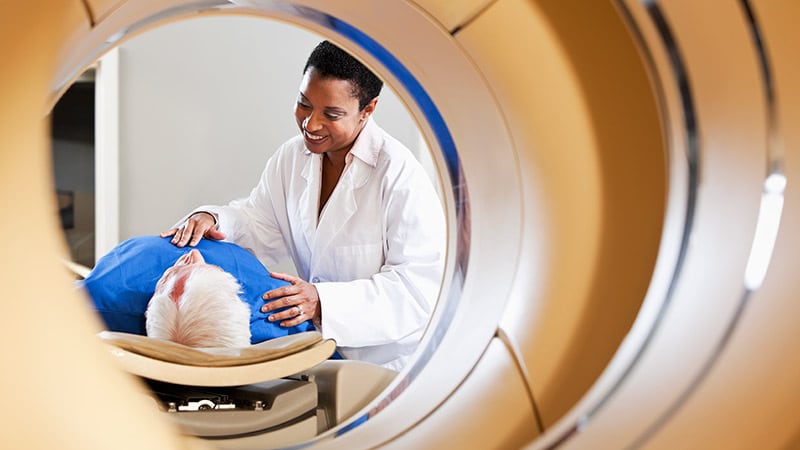Improved Prostate Cancer Staging with PSMA PET-CT Compared to MRI
المفاهيم الأساسية
PSMA PET-CT scans provide more accurate staging of prostate cancer compared to MRI, particularly in identifying extraprostatic extension, dominant nodules, and laterality.
الملخص
This study evaluated the performance of PSMA PET-CT versus MRI in staging prostate cancer in 134 patients scheduled for radical prostatectomy. Key findings:
- PSMA PET-CT correctly identified the final pathological tumor stage in 45% of patients, compared to 28% for MRI (p=0.003).
- PSMA PET-CT was superior to MRI in identifying the dominant nodule (94% vs 83%), laterality (64% vs 44%), and extracapsular extension (75% vs 63%).
- However, PSMA PET-CT was not better than MRI in detecting seminal vesicle invasion (91% vs 85%, p=0.07).
- PSMA PET-CT showed higher sensitivity for extracapsular extension (58% vs 33%), seminal vesicle invasion (57% vs 33%), and lymph node metastasis (50% vs 25%) compared to MRI.
- PSMA PET-CT also detected more Gleason grade 2 or higher nodules than MRI (29% vs 11%).
The authors conclude that PSMA PET-CT provides superior locoregional staging compared to MRI, which is critical for guiding surgical approach and novel focal therapies in prostate cancer.
تخصيص الملخص
إعادة الكتابة بالذكاء الاصطناعي
إنشاء الاستشهادات
ترجمة المصدر
إلى لغة أخرى
إنشاء خريطة ذهنية
من محتوى المصدر
زيارة المصدر
www.medscape.com
PSMA PET-CT Provides Staging Benefits Over MRI
الإحصائيات
PSMA PET-CT correctly identified final pathological tumor stage in 45% of patients, compared to 28% for MRI (p=0.003).
PSMA PET-CT was superior to MRI in identifying the dominant nodule (94% vs 83%), laterality (64% vs 44%), and extracapsular extension (75% vs 63%).
PSMA PET-CT showed higher sensitivity for extracapsular extension (58% vs 33%), seminal vesicle invasion (57% vs 33%), and lymph node metastasis (50% vs 25%) compared to MRI.
PSMA PET-CT detected more Gleason grade 2 or higher nodules than MRI (29% vs 11%).
اقتباسات
"High-risk features such as extracapsular extension are critical to identify on imaging before radical prostatectomy as their presence alters the surgical approach."
"Accurate identification of unilateral vs bilateral disease are important for novel treatments for patients with prostate cancer, such as focal therapies."
الرؤى الأساسية المستخلصة من
by Gargi Mukher... في www.medscape.com 07-19-2024
https://www.medscape.com/viewarticle/psma-pet-ct-provides-staging-benefits-over-mri-2024a1000dbv
استفسارات أعمق
What are the potential cost and resource implications of adopting PSMA PET-CT for routine prostate cancer staging compared to MRI?
The adoption of PSMA PET-CT for routine prostate cancer staging compared to MRI may have several cost and resource implications. While PSMA PET-CT has shown to provide superior locoregional staging benefits over MRI, it is important to consider the higher cost associated with PSMA PET-CT imaging. PSMA PET-CT scans are generally more expensive than MRI due to the specialized radiotracers used, the equipment required, and the expertise needed to interpret the results. This increased cost may pose challenges for healthcare systems and insurance providers in terms of reimbursement and affordability for patients. Additionally, the availability of PSMA PET-CT imaging facilities and trained personnel may be limited in certain regions, leading to potential resource constraints and longer wait times for patients. Therefore, the widespread adoption of PSMA PET-CT for routine prostate cancer staging would require careful consideration of cost-effectiveness, resource allocation, and infrastructure development.
How do the findings of this study compare to real-world clinical outcomes and patient management decisions?
The findings of this study, which demonstrate the superior staging accuracy of PSMA PET-CT compared to MRI in patients undergoing surgery for intermediate and high-risk prostate cancer, provide valuable insights into the potential benefits of using PSMA PET-CT in clinical practice. However, it is essential to consider how these research findings translate into real-world clinical outcomes and patient management decisions. In the real-world setting, factors such as patient comorbidities, institutional expertise, availability of imaging facilities, and healthcare system constraints may influence the implementation of PSMA PET-CT for prostate cancer staging. Clinicians must weigh the benefits of improved staging accuracy with the practical considerations of cost, resource availability, and patient access to determine the optimal imaging modality for individual cases. Patient management decisions should be guided by a multidisciplinary approach that takes into account the specific clinical context, treatment goals, and patient preferences to ensure personalized and effective care.
Could the improved staging accuracy of PSMA PET-CT lead to better long-term oncological outcomes for prostate cancer patients?
The improved staging accuracy of PSMA PET-CT has the potential to lead to better long-term oncological outcomes for prostate cancer patients by enabling more precise preoperative assessment and treatment planning. Accurate staging of prostate cancer, including the identification of extracapsular extension, seminal vesicle invasion, and lymph node metastasis, is crucial for determining the appropriate surgical approach, adjuvant therapies, and postoperative monitoring. By providing more detailed information about the extent and aggressiveness of the disease, PSMA PET-CT can help clinicians tailor treatment strategies to individual patients, leading to improved outcomes and reduced risk of disease recurrence. Additionally, the ability of PSMA PET-CT to detect small Gleason grade 2 or higher nodules that may be missed by MRI could facilitate earlier intervention and more effective management of prostate cancer. Overall, the enhanced staging accuracy offered by PSMA PET-CT has the potential to optimize patient outcomes, enhance treatment efficacy, and ultimately improve the long-term survival and quality of life for prostate cancer patients.
0
